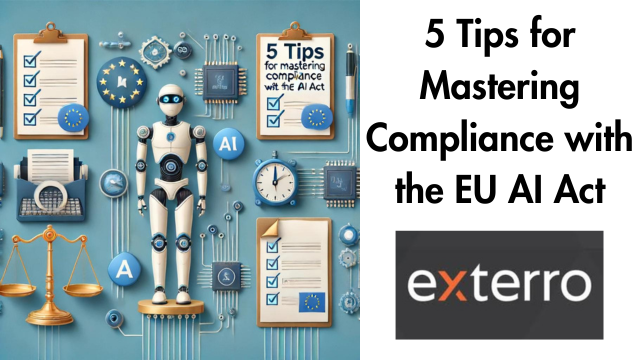

[EDRM Editor’s Note: This article is republished with permission and was first published on June 12, 2024.]
Artificial Intelligence (AI) is transforming industries by automating tasks, providing insights, and enhancing decision-making. However, as AI systems become more integrated into business processes, ensuring their ethical use and compliance with regulations is crucial. The European Union’s AI Act aims to regulate AI systems, especially high-risk ones, to ensure they are safe and respect fundamental rights.
For corporate legal and privacy professionals, navigating these regulations can be challenging. This guide offers five essential tips to help your organization comply with the EU AI Act, ensuring your AI systems are ethical, secure, and compliant.
Understanding the EU AI Act
The EU AI Act categorizes AI systems into four risk levels:
- Unacceptable Risk: Systems that pose significant threats to safety or rights, such as social scoring.
- High Risk: Systems used in critical sectors like healthcare, transportation, and law enforcement.
- Limited Risk: Systems requiring only transparency obligations.
- Minimal Risk: Systems with negligible risk, which are largely unregulated.
Curate Training Data
Tim. Rollins.
For high-risk AI systems, data governance is critical. Ensure that training, validation, and testing datasets are accurate, relevant, and free of biases. Implement processes for regular data review and updates.
Understanding where your AI systems fall within this framework is the first step to compliance. Once you’ve done that, you can progress through the rest of these recommended steps with confidence.
Download our Exterro-Bloomberg Law EU AI Act Compliance Checklist for more detailed information!
Compliance Tip 1: Establish a Robust Risk Management System
Identify and Classify Risks
Start by identifying all AI systems in use within your organization. Classify these systems according to the EU AI Act’s risk categories. High-risk systems, such as those used in recruitment or critical infrastructure, require more stringent controls.
Implement Continuous Monitoring
Develop a risk management framework that includes continuous monitoring of AI systems. Use metrics and benchmarks to measure performance, and regularly review these against compliance requirements.
Engage Stakeholders
Involve key stakeholders, including IT, legal, and business units, in the risk assessment process. Ensure everyone understands their roles and responsibilities in managing AI risks.
Compliance Tip 2: Ensure Data Governance and Quality
Curate Training Data
For high-risk AI systems, data governance is critical. Ensure that training, validation, and testing datasets are accurate, relevant, and free of biases. Implement processes for regular data review and updates.
Document Data Sources
Maintain detailed documentation of data sources, collection methods, and processing techniques. This transparency helps in demonstrating compliance during audits and assessments.
Implement Data Protection Measures
Adhere to data protection laws like GDPR. Ensure personal data used in AI systems is anonymized or pseudonymized, and establish protocols for data security and privacy.
For the remaining tips, please click here to read the original article.


